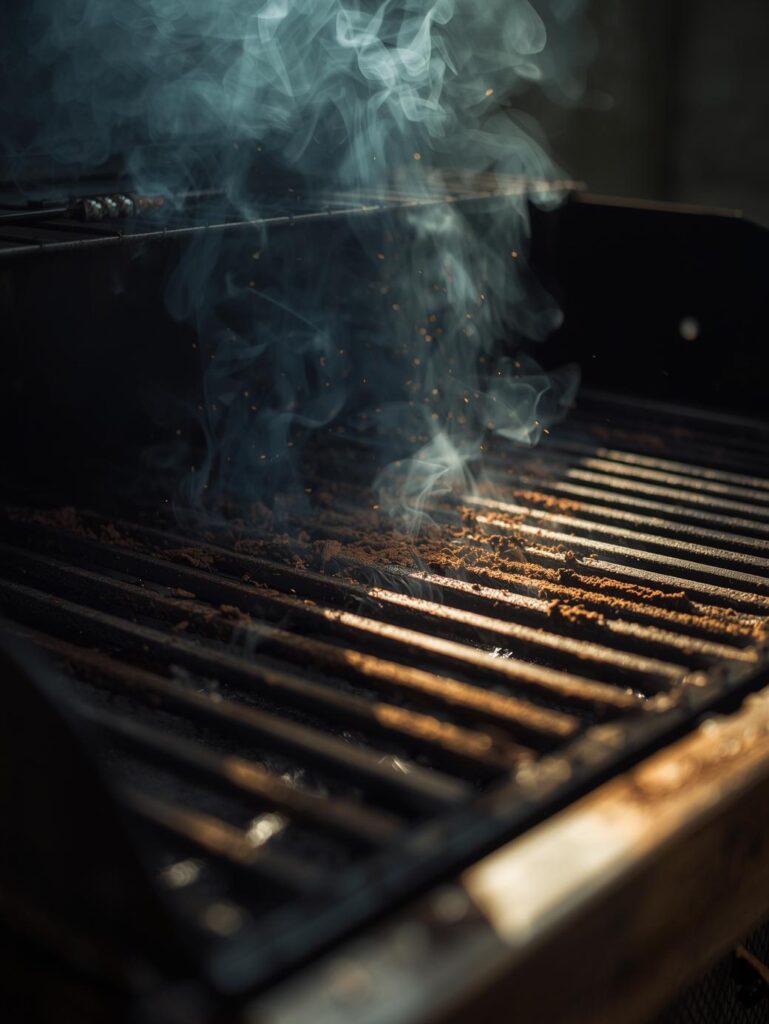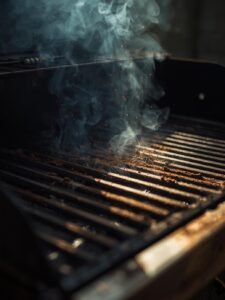Expert’s Note: This guide is part of our comprehensive Ultimate Grill & Smoker Maintenance Guide. Master rust prevention to protect your investment for decades.
Table of Contents Hide Contents🛡️ GRILL RUST PREVENTION GUIDE – KEEPING YOUR GRILL LOOKING NEW FOR YEARS
“Rust doesn’t care if you spent $300 or $3,000 on your grill – it treats them all the same. But with the right knowledge, you can stop it in its tracks and add years to your equipment’s life.”doesn’t care if you spent $300 or $3,000 on your grill – it treats them all the same. But with the right knowledge, you can stop it in its tracks and add years to your equipment’s life.”
Grill Rust Prevention: Protect Your Equipment and Extend Its Lifespan
Build your rust-fighting toolkit with our essential product recommendations and maintenance schedule.
🔥 Understanding Your Enemy: How Rust Works
Rust might seem like magic, but it’s simple chemistry: iron + oxygen + water = rust. The heat from your grill actually accelerates this process, and when you add salt from marinades or acidic sauces, you’ve created the perfect storm for corrosion.
🎯 Common Rust Hotspots to Watch:
- Bottom of firebox – moisture and heat create a steam bath
- Legs and wheels – ground contact and water splash
- Bolt connections and hinges – moisture traps in tight spaces
- Grease management systems – acidic byproducts accelerate corrosion
🛡️ The 3-Layer Rust Defense System
🟢 Layer 1: Prevention (Daily/Monthly)
Your first line of defense is simple habits:
- Always cool and dry your grill before covering
- Empty grease trays after each major cook
- Use a grill cover that breathes (prevents condensation)
- Store pellets and charcoal in dry conditions
🟡 Layer 2: Maintenance (Seasonal)
Proactive care stops small problems early:
- Quarterly full inspections of all surfaces
- Touch-up painting on scratches and chips
- Lubrication of moving parts with high-heat lubricant
- Deep cleaning before seasonal changes
🔴 Layer 3: Treatment (As Needed)
When rust appears, act quickly:
- Immediate spot treatment of any rust areas
- Professional assessment of structural damage
- Part replacement when protection fails
⚙️ Grill-Specific Rust Prevention Guides
🥘 Cast Iron Grates & Components
Your best defense is a good seasoning layer. This polymerized oil coating acts as a barrier against moisture and oxygen. Clean with brass brushes that don’t strip seasoning, and never use soap that breaks down this protective layer.
✨ Stainless Steel Surfaces
Contrary to popular belief, stainless steel CAN rust. The chromium oxide layer that protects it can be damaged by abrasive cleaners or steel brushes. Stick to stainless-safe cleaners and avoid chlorine-based products.
🍶 Porcelain-Coated Parts
The porcelain coating is essentially glass – once chipped, the underlying steel is exposed and vulnerable. Prevent impacts, use nylon brushes, and touch up any chips immediately with high-heat paint.
🎨 Painted Steel Surfaces
Most grill bodies fall into this category. Use only high-heat paint (rated to 1200°F+), properly prepare surfaces by removing all rust and grease, and apply thin, even coats.
Pro Tip: Keep a small touch-up paint pen matched to your grill’s color. Quick treatment of scratches prevents 90% of rust problems before they start.
🧰 The Ultimate Rust Prevention Toolkit
🛒 Essential Products:
- High-heat spray paint (black, silver, your grill’s color)
- Rust converter – turns rust into protective coating
- Grill-specific lubricant for hinges and wheels
- Protective spray for stainless surfaces
🔧 Tools Needed:
- Wire brushes (various stiffness for different jobs)
- Sandpaper (80 grit for heavy rust, 220 for finishing)
- Metal primer for bare steel
- Small brushes for detailed work
📅 Seasonal Rust Prevention Calendar
🌸 Spring Startup
- Remove winter cover and inspect for moisture damage
- Touch up any paint chips from winter
- Lubricate all moving parts
- Check for pest nests that trap moisture
☀️ Summer Maintenance
- Increase cleaning frequency in humid conditions
- Ensure proper cover usage after rains
- Watch for salt damage if grilling seafood frequently
- Check for ash accumulation (alkaline, promotes rust)
🍂 Fall Preparation
- Deep clean before storage season
- Apply protective coatings to vulnerable areas
- Address any rust spots before winter
- Ensure proper storage location
❄️ Winter Protection
- Outdoor storage: Use a breathable cover, elevate off wet surfaces
- Indoor storage: Ensure complete dryness before storing
- Regular check-ins monthly for moisture issues
🔧 Rust Treatment: When Prevention Fails
🎨 Surface Rust Treatment
- Assessment: Is it surface rust or deep pitting?
- Mechanical removal: Wire brush or sandpaper
- Chemical treatment: Rust converter application
- Protection: Primer and high-heat paint
⚒️ Advanced Rust Repair
- Small holes: High-heat epoxy putty
- Large areas: Professional welding or replacement
- Structural damage: Always replace for safety
💸 Replacement Guidelines
- Cost under $50: Usually worth replacing
- Structural components: Always replace if compromised
- Aesthetic parts: Consider DIY repair first
❌ Common Rust Prevention Mistakes
🚫 What to Avoid:
- Using regular spray paint (it will burn off and smell terrible)
- Covering a damp grill (creates a steam room)
- Ignoring small rust spots (they grow exponentially)
- Using abrasive pads on stainless steel
- Storing grill with ash or grease residue
Avoid These Errors: Learn from common mistakes:
🔬 Your Sunday Experiment: Rust Prevention Audit
📋 This Weekend’s Mission:
1. 🔍 Complete Inspection (10 minutes)
- Examine all surfaces in good light
- Note any rust spots, chips, or scratches
- Check moisture traps and hard-to-see areas
2. 🛠️ Quick Treatment (15 minutes)
- Address one trouble spot immediately
- Apply lubricant to moving parts
- Verify your cover is breathable and fitting properly
3. 📝 Prevention Plan (5 minutes)
- Schedule your next seasonal maintenance
- Add rust inspection to your monthly routine
- Identify any needed supplies
🎁 What You’ll Gain:
- Peace of mind knowing your investment is protected
- Consistent grill performance season after season
- Significant money saved on replacement parts
- Professional-looking equipment that performs like new
Ready for Your Sunday Experiment?
Join thousands of grill owners who have defeated rust and kept their equipment looking new for years.
Rust prevention isn’t a one-time task—it’s a mindset. The few minutes you spend this weekend on inspection and treatment will pay you back in years of reliable service and perfect performance.
Start with that simple 10-minute inspection. Your future self will thank you every time you fire up that clean, rust-free grill.
Quick Note: These questions are answered in detail in our full guide above. This FAQ summarizes the key points for quick reference.
❓ FAQ: RUST PREVENTION GUIDE
🛡️ 1. What’s the single most important thing I can do to prevent rust?
Keep your grill dry and covered. Moisture is rust’s best friend. Always ensure your grill is completely cool and dry before putting on the cover, and use a breathable cover that prevents condensation buildup.
🔧 2. Can I use regular spray paint on my grill?
Absolutely not. Regular spray paint will burn off, smell terrible, and potentially contaminate your food. Always use high-heat paint rated for at least 1200°F specifically designed for grills and engines.
⏰ 3. How often should I inspect my grill for rust?
Monthly quick checks and seasonal deep inspections. Do a 2-minute visual scan monthly, and a thorough 15-minute inspection at each seasonal change (spring, summer, fall, winter).
🎨 4. What’s the difference between rust converter and regular paint?
Rust converter chemically changes rust into a stable, protective coating that you can paint over. Regular paint just covers the surface. For existing rust, always use converter first, then paint for protection.
🧽 5. Will cleaning my grill too often cause rust?
No, but cleaning it wrong might. Proper cleaning prevents rust by removing moisture-trapping debris. However, using abrasive tools that damage protective coatings or leaving the grill wet after cleaning can cause problems.
🌧️ 6. Is it safe to leave my grill outside year-round?
Yes, with proper protection. Use a quality breathable cover, elevate the grill off wet surfaces, and perform seasonal maintenance. In harsh winter climates, consider indoor storage if possible.
💰 7. When should I replace parts vs. repair rust damage?
Replace if: Structural integrity is compromised, cost exceeds 50% of new part price, or repair would be temporary. Repair if: Damage is surface-level, part is expensive, or it’s a simple cosmetic issue.
🔥 8. Can high heat actually cause rust?
Yes, indirectly. Heat accelerates chemical reactions, including oxidation (rust). The thermal cycling of heating and cooling also expands and contracts metal, creating micro-fractures where rust can start.
🛒 9. What should I look for in a quality grill cover?
Breathable material, water-resistant (not waterproof), UV protection, and proper fit. Avoid vinyl covers that trap moisture and cause “sweating” that accelerates rust.
⚡ 10. How quickly should I treat new rust spots?
Immediately. Small surface rust spots can be treated in 15 minutes. Left untreated, they can spread significantly within weeks, especially in humid conditions.
🧴 11. What’s the best oil for protecting bare metal?
High-smoke point oils like grapeseed, avocado, or vegetable oil work best for temporary protection. For long-term protection, use dedicated metal protectants or high-heat paint.
🔍 12. How can I tell if rust is just surface-level or structural?
Surface rust: Flakes off easily, metal underneath is solid. Structural rust: Creates holes, metal feels soft or crumbly, affects grill stability or safety.
Still have questions? Drop them in the comments below or explore our Complete Grill Maintenance Guide for more detailed information.



